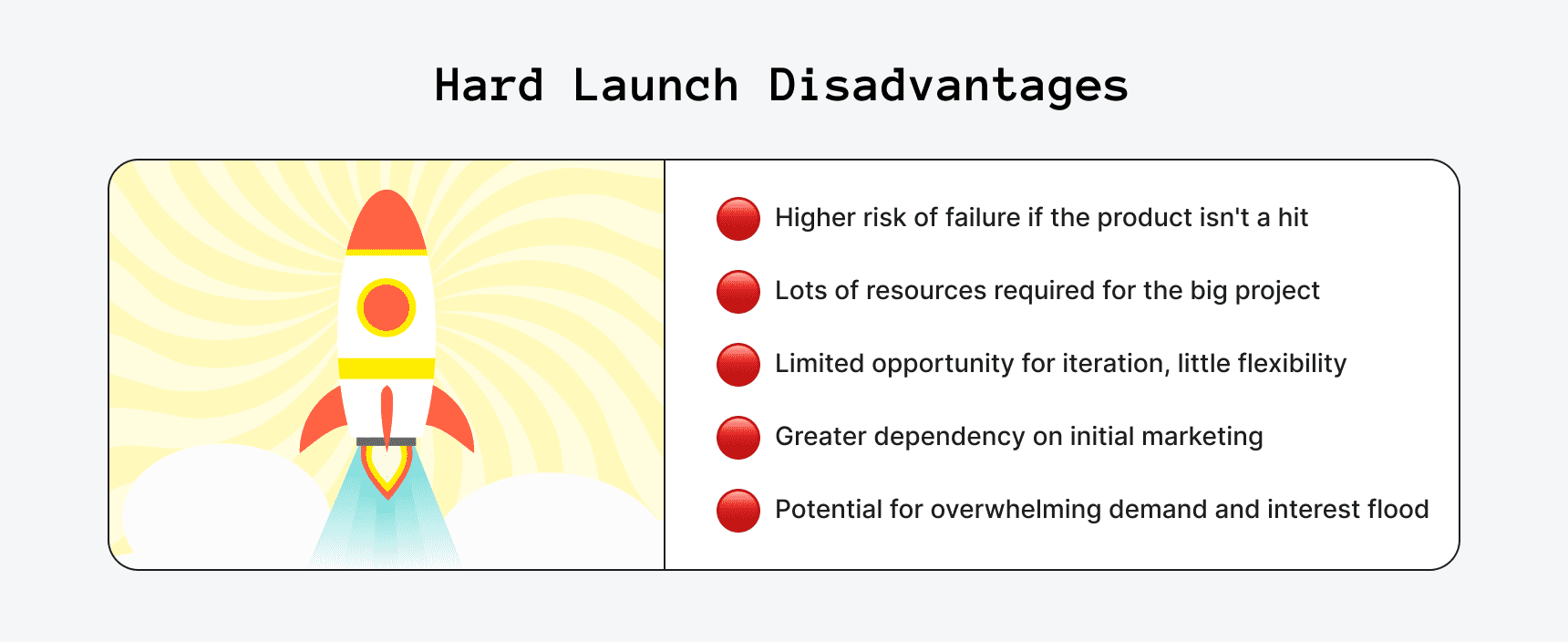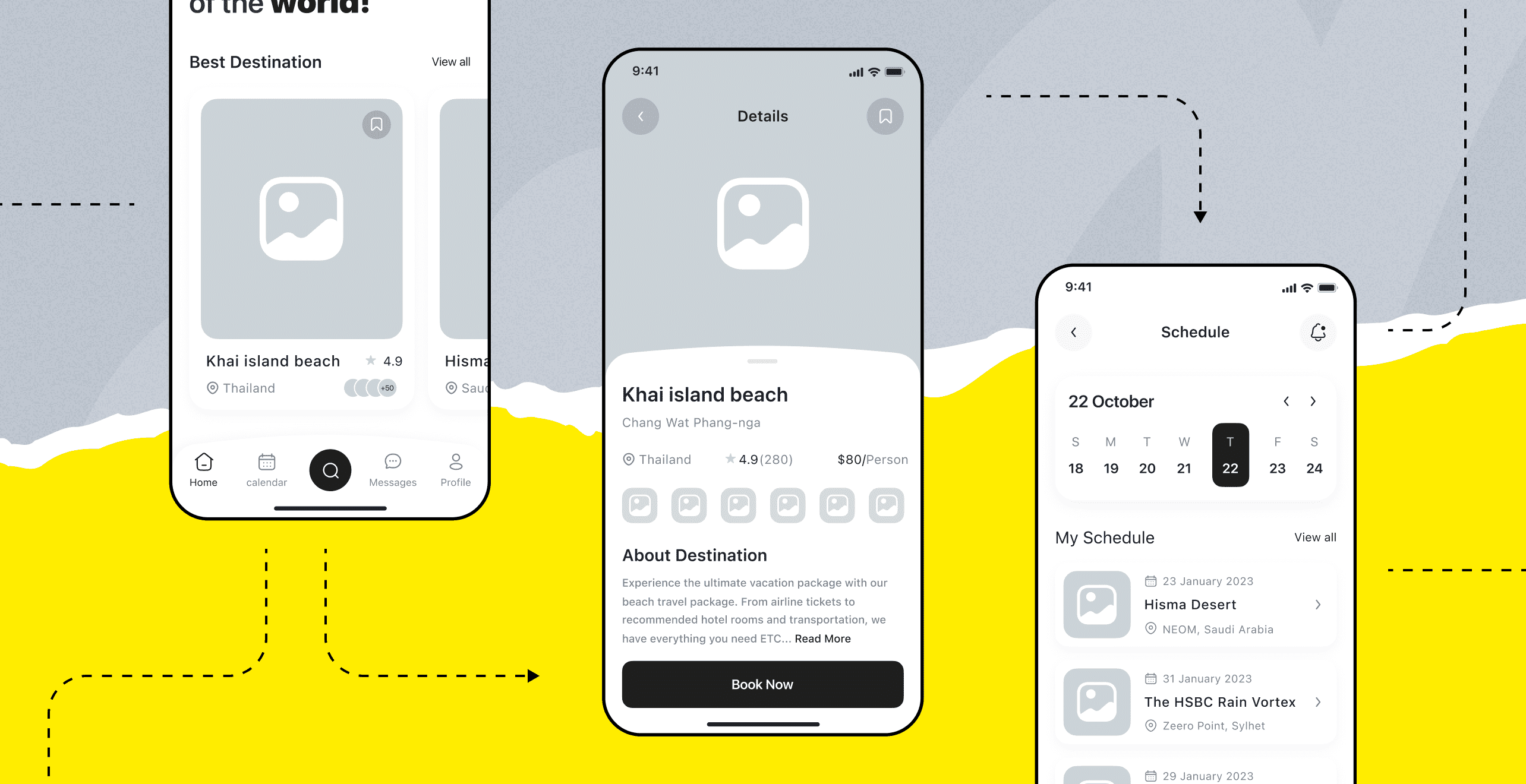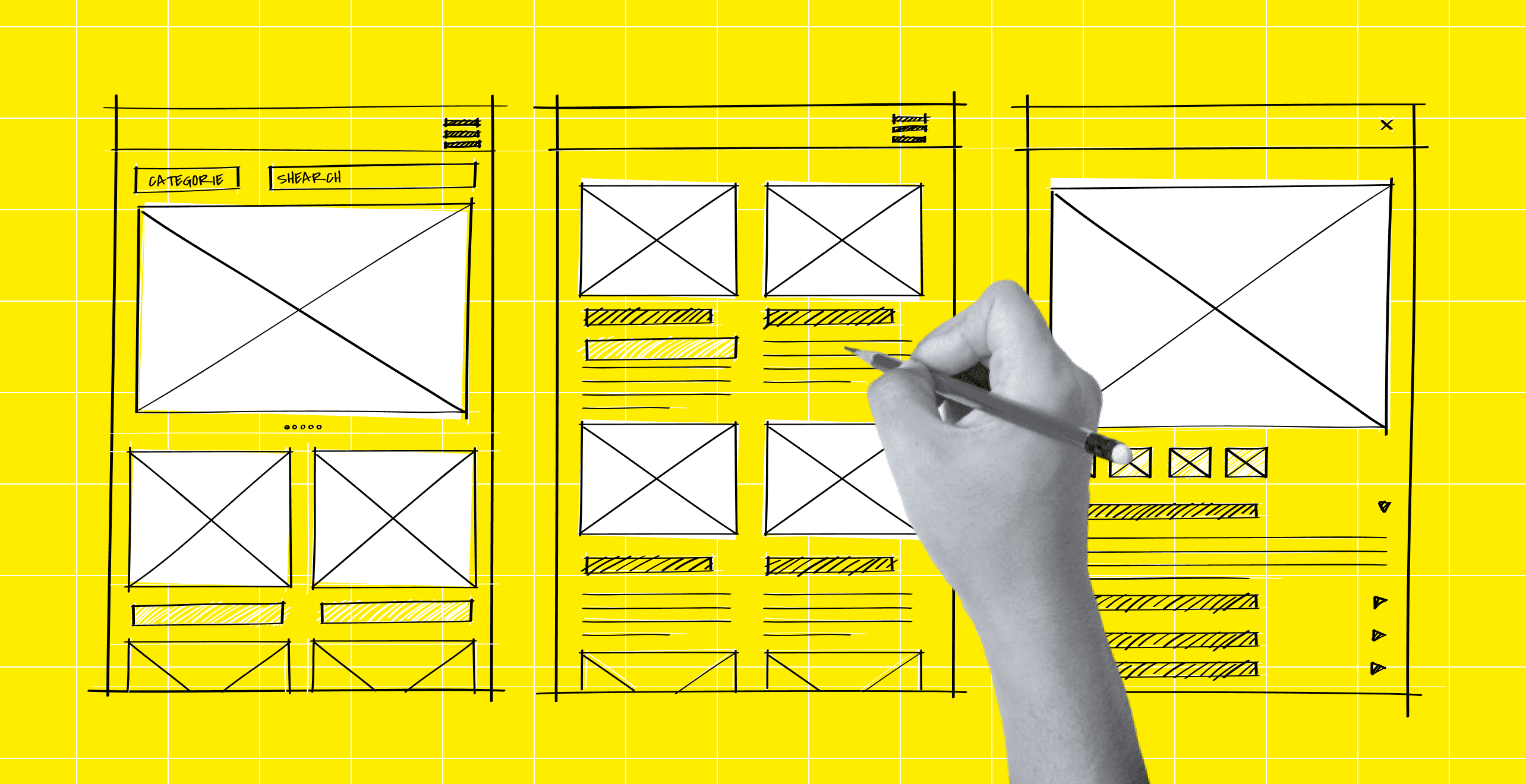Soft Launch vs Hard Launch: A Comparative Guide for Startups

Every entrepreneur faces the exciting moment of launching their product. While a launch-and-see approach might be tempting, established strategies can significantly improve your success.
According to G2, the product launch can cost anywhere from a cool ten grand to, well, let's just say yacht money. Before you blast off with a launch-and-pray strategy, let's talk tactics. We'll explore the two major types of launches: soft launch and hard launch, to see which one will make your product the next big thing.
What's a Soft Launch?
The soft launch: it's like wading into the product pool instead of a full-on belly flop. You test the temperature with a smaller audience, see if any surprises are lurking at the bottom, and avoid a potential faceplant in front of everyone.
Understanding a Soft Launch Strategy: Definition
The product soft launch considers releasing your software, app, or digital thingy to a limited crew before splashing it out to the whole world. Why? Smart developers use this time to test the waters, squash any bugs hiding in the shallows, and see what users really think. Think of it as a practice run to avoid a total wipeout on launch day.
Targeting a specific group lets you refine your product based on real feedback. Making your app super user-friendly before everyone dives in is a good move, right? Plus, a soft launch can build some early buzz and get people excited without all the risk of a giant launch.
This soft launch strategy is especially golden in the tech world where user feedback is king (or queen). This is the path often chosen when starting a startup.
Let's crack open the good and the bad of this strategy to see if it fits your product like a perfectly sized pool float.
Benefits of the Soft Launch
Here are all the cool things a soft launch brings to the table, piece by piece.

Risk Reduction
A soft launch is the safest way for entrepreneurs. It gives you a chance to try out your product in the wild without the full-on stress of a big launch. It's a business safety net, so you can spot and fix any big problems early, dodging a public flop that might ding your brand's image and future chances.
Feedback and Improvement
Snagging feedback from your first wave of users is pure gold for tweaking your product. Grab this chance to dig into what they love, what's not hitting the mark, and the extra goodies they're craving. This straight-up feedback loop is your unique offering to smarten up your product, make a product or startup pivot if needed, and make sure the final version is a hit and checks all the right boxes in the market.
Market Validation
Checking if your product jives with the market is key before you go all in with a big launch. A soft launch provides a low-risk platform to assess demand and user engagement and validate product hypotheses. It's your chance to measure the buzz and figure out if your product's got the chops to make it loud or if you need to tweak things to meet what the market's really looking for.
Cost Efficiency
Kicking things off with a soft launch is a wallet-friendly move, perfect for entrepreneurs watching their spending or those with a limited startup budget. It means you can zero in on your marketing and bucks for a more bite-sized audience, cutting down your upfront cash splash. This exactly makes it a paramount perk of soft vs hard launch. Then, armed with how it all goes down and what people are saying, you can smartly spread out your budget for the grand reveal.
Build Anticipation
Building a hype train around your product with a bit of mystery and VIP vibes can be a killer marketing move. A soft launch lets you whip up some early excitement and get folks talking, paving the way for a tidal wave of interest when you're ready to roll out the red carpet for the bigger launch. It's like setting up a line of people waiting for a spectacular market entrance.
Disadvantages of the Soft Launch
A soft launch has its perks, but let's be real — it's not a cure-all. While it packs a bunch of advantages, it also comes with its own set of headaches that you have to keep an eye out for.

Limited Exposure
In a soft launch, you're only showing your product to a tiny slice of your potential audience, which might put a bit of a damper on your early growth spurt. For the up-and-coming entrepreneur, it's all about finding that sweet spot between enjoying the perks of a low-key launch and chasing the bigger picture of getting your brand and product out there to more people.
Potential Revenue Loss
Going for a limited launch means you could be leaving some early cash on the table, especially if it turns out there's a huge appetite for what you're selling. It's a bit of a balancing act, figuring out if fine-tuning your product is worth the possible hit to your short-term earnings. Making sure those long-term wins are going to be worth the early trade-offs is key.
Resource Allocation
Juggling a soft launch while gearing up for the final show can really stretch your resources thin. As an entrepreneur, it's crucial to map out and divvy up your team's energy and assets smartly and make sure you give both the soft launch and the full-scale rollout the love and resources they need to shine.
Competitive Risk
Letting your product peek out into the market, even just a little, means your rivals might spot it and hustle to mimic your features or tactics. It's similar to the risk you take when building in public. To keep your edge sharp, be careful about what you spill during the soft launch and get ready for how the competition might hit back.
Data Skew
Hearing from just a handful of folks during a soft launch might not give you the full picture of what the wider world wants or does. As you try to analyze your product or MVP success, be savvy about reading into the feedback and data you snag, and think about throwing some more market research into the mix to make sure your big launch decisions are on solid ground.
Examples of Successful Soft Launches
Even though soft launching has its downsides, there are plenty of success stories out there. Some companies have really nailed balancing the cons and leveraging the pros of easing into the market.
Did you know that Burnb was the first name for the Instagram app? It's just one of the fascinating facts that are long forgotten because these companies have done a great job turning their soft launches into real success.
- Instagram — Before it took the world by storm, Instagram started life as Burbn, an app all about sharing photos based on where you were. The creators took the hints they got from this early, smaller launch, and decided to streamline and shift focus, which set the stage for Instagram's rocket ride to success.
- Spotify — Before hitting the central stage time in the U.S., Spotify tested the waters with a soft launch in a few European countries. This move let the music streaming giant fine-tune its service, hammer out licensing agreements, and whip up excitement, all of which played a huge part in its worldwide hit status.
- Dropbox — When it was in its early stages of startup development, Dropbox kicked things off with a beta version for a select group, going the soft launch route. This strategy was a key event for the cloud storage leader, which allowed them to collect valuable user insights, enhance their offering, and polish a referral program that went viral. These actions massively ramped up their user count when they officially launched.
- Airbnb — Airbnb started off with a soft launch, zeroing in on the 2008 Democratic National Convention as a testing ground for their idea of home rentals. The success and insights gained from this specific event were pivotal. Specifically, they helped mold the platform's growth and startup marketing strategy approaches and set the stage for its leap onto the global scene.
- Angry Birds — Rovio took Angry Birds for a test flight in Finland and a few other small markets initially, aiming to gauge its allure and rake in feedback. The thumbs-up from these early launches and the golden nuggets of insight they collected were indispensable. They used this info to refine the game and tweak their marketing playbook. You already know it turned out to be a total blockbuster global launch.
You might have already assumed some of the differences between smaller and bigger launches as we've covered what's a soft launch. However, take some time to check out the next section and find out if the hard launch is what you expect it to look like.
What's a Hard Launch?
We've covered the soft launch, so it's time to find out what's a hard launch. Basically, the throw-it-out-there-and-cross-your-fingers strategy. It's a high-stakes game where you roll the dice and hope it pays off, otherwise, you're looking at a potentially huge loss.
Understanding a Hard Launch Strategy: Definition
The product hard launch is the go big or go home and this is the main difference between soft and hard launch. This is when a company goes all in, rolling out its product or service to the whole target audience in one fell swoop, complete with major marketing muscle and a lot of noise. It's the polar opposite of the cautious, step-by-step soft launch, opting instead for a wide release right off the bat.
A hard launch is about making a splash, grabbing attention fast, and snatching up as much of the market as you can, pronto. This usually means pulling out all the stops with a killer marketing blitz across every channel imaginable: social media blasts, ad campaigns, press buzz, you name it. The aim? To get people talking and buying, right from the get-go.
Benefits of the Hard Launch
Sure, it sounds like a high-stakes gamble, especially when the softer, more measured approach is an option. Why risk a fortune on a make-or-break debut? Let's see why companies choose hard vs soft launch.

Immediate Market Impact
As already mentioned, a hard launch goes for the big splash, aiming to hit the market like a lightning bolt. By unleashing the product on the entire target audience all at once, companies look to spark instant buzz and grab a chunk of the market right out of the gate, marking their territory with a bold first impression.
Maximizing Marketing Momentum
In a hard launch, all marketing tools blaze at once and create a unified and mighty campaign across different platforms. It requires a lot of work and a solid startup branding strategy. But this synchronized effort can cause a ripple effect of customer curiosity and interaction. It uses that initial burst of energy to spread the word far and wide and aims for the highest visibility and broadest reach possible.
Capitalizing on First-Mover Advantage
When you're diving into new or budding markets, a hard launch can snag you that coveted first-mover spot. Getting your product out there before anyone else can plant your flag as the trailblazer, set the pace for any rivals, and maybe even lock in a leading role in the market.
Clear and Focused Launch Timeline
A hard launch operates on a tight schedule, with a sharp countdown to D-day. This clarity makes planning and pulling off the launch simpler. It enables a laser-focused and synchronized push across the whole team.
Immediate Revenue Generation
Going all in from the start means companies can kickstart their revenue stream right away, serving up their product to everyone in their sights. This immediate cash flow is one of the most useful perks of a hard launch vs soft launch and can be a product life-saver, especially for startups that need to show their startup valuation or any business under pressure to show they're financially sound and ready to roll.
Sounds like a great bunch of benefits that could be applied in particular cases, right? Some products purely require such an approach to get to the market and properly position themselves. But for sure, the drawbacks of hard vs soft launch are serious and sometimes dangerous.
Disadvantages of the Hard Launch
The list of perks sounds pretty sweet, but let's not kid ourselves — there's always a catch. Let's peel back the curtain and see what kind of trade-offs are hiding behind the scenes of a hard launch.

Higher Risk of Failure
Going big with a hard launch means you're putting your product out there for the whole world to see all at once. So, if there's a hiccup or folks aren't thrilled, the fallout can be massive. A misstep could tarnish your company's reputation and hit the finances hard, especially if the product doesn't live up to the hype. In fact, this is one of the startup failure reasons.
Increased Pressure on Resources
Pulling off a hard launch is a big deal that demands a lot: hefty marketing dough, a bunch of people, and all sorts of logistics. This can really stretch a company thin, particularly if it's a startup, possibly pulling focus and energy away from other key areas that need attention. Running out of cash too soon is among the common startup mistakes, hence, thorough planning is integral.
Limited Opportunity for Iteration
Unlike the more laid-back soft launch, which lets you tweak things based on early feedback, a hard launch doesn't give much wiggle room for making adjustments on the fly. If you need to fix or fine-tune your product after it's hit the market full force, you're in for a tougher ride and might need to throw even more resources at it to get things right.
Greater Dependency on Initial Marketing
Nailing a hard launch is super dependent on your marketing being on point. If that initial blitz doesn't land just right, bouncing back can be a real uphill battle because, let's face it, you only get one shot at that first splash.
Potential for Overwhelming Demand
Aiming for a tidal wave of demand with a hard launch sounds great, but it's a bit of a tightrope walk. Get it right, and you're golden; but if you're not fully geared up to handle the flood of interest, you could end up with unhappy customers, lagging deliveries, and a dent in your brand's trustworthiness.
Examples of Successful Hard Launches
It does sound like a high-stakes game, doesn't it? But that's the gamble the companies below took by choosing hard launch vs soft launch, and it's part of what propelled them to the lofty heights they're enjoying today. Here's the list of players who were big right from the beginning.
- Apple iPhone — Apple is like: "What's a soft launch?". They crank up the hype with slick marketing and flashy media events, then drop the product everywhere all at once on a set date. The result? A tsunami of initial sales and a media frenzy.
- Tesla Model 3 — Tesla's rollout of the Model 3 electric car was a hard launch done with all the bells and whistles. They pulled the curtain back and started snagging pre-orders right off the bat, sparking a flood of reservations and catching the eye of media outlets everywhere.
- Microsoft Windows 95 — The debut of Windows 95 stands as one of the tech world's most legendary hard launches. Microsoft went all in, splurging on marketing like a globally broadcasted launch party and a massive advertising blitz. As a result, off-the-charts sales and a spot in virtually every computer user's home.
- Google Pixel Phones — Google has thrown its hat in the ring with hard launches for its Pixel smartphones, syncing up worldwide release dates and rolling out broad marketing campaigns. Their plan was to go toe-to-toe with the smartphone heavyweights and quickly carve out a piece of the market pie for themselves.
- Amazon Prime Day — Even though it's not about launching a new product, Amazon Prime Day is a prime example of how a hard launch strategy can supercharge a sales event. Amazon hypes it up and slashes prices on a fixed date, which not only boosts sales but also ropes in a bunch of new Prime members.
See? These guys have taken all from the hard launch strategy and succeeded. Sure, pulling off a hard launch means there's a ton of prep work — like deep-diving into market research and analysis, nailing your product's spot in the market, and really getting to know your target audience, but the fair days' work pays off.
Now that we've unpacked both the soft and hard launch tactics, let's dive into how you can harness either strategy to make your product debut a smashing success. Whether you lean towards a cautious, step-by-step rollout or decide to go all in with a big bang, there's a lot to consider to really nail it.
Soft Launch vs Hard Launch: How to Choose Between Them?
Picking your launch strategy is a vital decision. This choice hinges on a bunch of different factors, but to help streamline the process, let's lay it all out in a comparative table of soft launch vs hard launch:
Simply saying:
- choose a soft launch when you need to test and refine your product, manage risks, or enter uncertain markets;
- opt for a hard launch when your product is ready, there's clear market demand, and you aim to make a significant impact quickly with ample resources at your disposal.
To get a clearer picture of the best launch strategy for your specific product and market scenario, let's review the factors you should weigh when deciding on using the soft vs hard launch approach.
Factors to Consider When Choosing a Launch Strategy
To pinpoint the launch strategy that'll suit your product like a glove, you should carefully evaluate each of the following factors.

1. Product readiness and its nature
- Check if your product is ready to roll and has undergone thorough QA testing.
- Mull over your product's complexity, its level of innovation, and how it slots into the current market scene.
2. Market understanding and target audience
- Get a grip on the market's appetite and what your competitors are up to.
- Pin down who your ideal customers are, what they dig, and how they might vibe with your product.
3. Resource availability
- Take stock of what you've got in your arsenal, like cash, team skills, tech stack, and tools.
- Think about how these assets back up your launch plan and what comes after.
4. Risk tolerance
- Figure out how much uncertainty you and your company can handle.
- Choose between going all-in with a hard launch or taking a more cautious route with a soft launch to keep risks in check.
5. Feedback and iteration
- Ponder how crucial early feedback is for making your product even better.
- Decide if an agile MVP and an iterative approach, tweaking the product based on user input (a hallmark of soft launches), suits your plan.
Given these considerations, different products naturally lean toward specific launch strategies. To clue you in on where your product might fit best, let's explore the most common scenarios where a soft launch could be the winning move.
Scenarios When a Soft Launch Is Appropriate
Choosing soft vs hard launch might just hit the mark if:
- You're keen on giving your product or service a trial run with a select group before unleashing it in the world.
- You aim to catch any sneaky glitches, bugs, or snags through detailed testing.
- You're looking to stir up some buzz and get people excited about what's coming.
- You're all about tweaking and refining your strategy based on the feedback and intel you collect during the soft phase.
- You see the value in taking a moment to assess how your product's doing and polishing it up before the grand debut.
Scenarios When a Hard Launch Is the Best Solution
Choosing a hard launch vs soft launch is your best bet in scenarios like:
- Your product has passed all its tests with flying colors and you're solid on its performance.
- You're aiming to cause a stir and get your target audience super pumped.
- Your plan for rollout is airtight, ready to tackle the surge in demand.
- You're set to drop the curtain and get the word out with a bang.
- You're all in, ready to channel your resources and marketing muscle to hit those high conversion rates.
- You've got that edge to make you shine brighter than the rest in the market.
- You're looking to see the cash flow quickly, riding the wave of your product's launch hype.
- There's a large enough crowd out there, giving you the green light for a widespread launch.
Is There a Middle Ground?
If your product sits in a grey area, mixing elements from both sides of the launch strategy spectrum, don't sweat it — this dilemma isn't new, and there's a savvy solution. The hybrid approach might be your golden ticket, marrying the best of both worlds to amplify the upsides and dial down the downsides of soft launch vs hard launch.

The idea is to kick things off with a soft launch. This phase's purpose is to collect crucial data and feedback and get the lay of the land in terms of market vibes. You can build a minimum viable product to do so. Once you've sifted through the initial responses, ironed out any kinks, and given your product a little polish, it's showtime for the hard launch. Now you're stepping out with confidence, backed by a beefed-up marketing push, ready to charm a broader crowd.
Opting for this hybrid technique lets you tweak and tailor your product and its pitch with the clarity that only comes from real-world reactions. Then, taking advantage of these insights, you gear up for a louder, bolder introduction to the market.
Benefits of the Hybrid Launch Approach
First, this strategy gives businesses the soft launch perks, or the chance to make an initial foray, gauge reactions, and adapt based on what actually happens out there in the market.
Next, kicking off with a soft launch means you get a sneak peek at potential stumbling blocks, a chance to smooth things out before you go big and commit major resources to a widespread launch.
Finally, that initial soft launch isn't just about testing; it's also about generating excitement and curiosity. This buzz can then be harnessed and turned up for the hard launch, making sure your product lands with a splash.
Final Thoughts on Hard Launch vs Soft Launch of a Startup
Guiding through the paths of market entry strategies can be a real brain teaser, with each product and proposition demanding its unique approach to hit the ground running and start bringing in the cash. Regardless of whether you lean towards a soft or hard launch, one thing's for certain: The intensive market study is enough to turn sleep into a luxury for many entrepreneurs, keeping them up at night.
Now, if counting sheep is more your style and you're not keen on trading in precious sleep for business plans, Upsilon's team has got your back. Armed with the know-how and expertise for making a splash in the market, we're here to take the midnight oil out of the equation and ensure your business takes off while you get to hold onto those sweet dreams. So, don't be shy to reach out to us for MVP development services or to discuss the project you have in mind, we'll be glad to help!
to top











